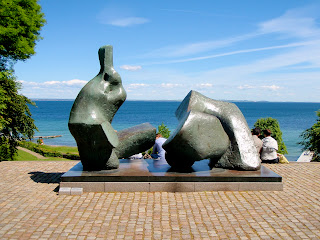For today's class, we had the great opportunity of visiting the Hirschsprung Collection and the Louisiana Museum Sculpture Park. The two museums were very different, in that the Hirschsprung Collection showcased several different paintings that depicted the Danish landscape during the Danish Golden Age of Painting, where as the Louisiana Museum showcased a variety of contemporary art, consisting of sculptures and paintings.
The main focus of the class was on the Danish Golden Age of Painting, a period of time that was distinguished by a very particular style of portraying Danish Landscapes. Scenes were typically painted as idealized versions of their actual realities, and were manipulated under the discretion of the artist. In doing this, artists helped shape the perception of the Danish landscape at the time, depicting it as a vibrant and colorful environment that was full of life. Another characteristic of these paintings, was the apparent absence of the artist's brush strokes, which made the paintings more valuable.
As explained by our tour guide, the horizon of the paintings were lowered in order to open up the sky and make it appear brighter. This was seen as a way to link heaven to earth. As well, paintings during this time period rarely depicted the winter months, since they were considered dreary and dark. In many cases where portraits were captured during seasons such as fall, they would often be touched up and altered in order to depict spring and summer months.
I found this to be quite unusual, but realized that this optimistic style of painting was a way of cheering people up during hard economic times. The paintings acted as an outlet for many people during these tough times, similar to the way that public greenspaces do in present day.





No comments:
Post a Comment